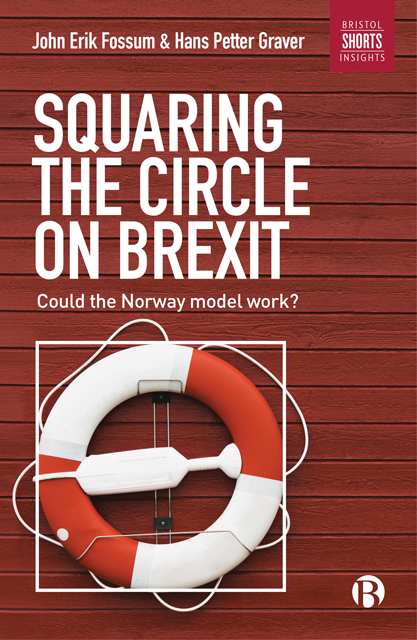Book contents
- Frontmatter
- Contents
- Foreword
- Preface and acknowledgements
- List of abbreviations
- Introduction
- 1 What does Britain want from Brexit?
- 2 Forms of affiliation with non-members
- 3 What is the Norway model?
- 4 The challenge of sovereignty
- 5 What can Britain learn from Norway’s experience?
- 6 Would Britain be an ‘elephant in the boat’?
- Conclusion
- Notes
- References
- Appendix
- Index
Conclusion
Published online by Cambridge University Press: 21 April 2023
- Frontmatter
- Contents
- Foreword
- Preface and acknowledgements
- List of abbreviations
- Introduction
- 1 What does Britain want from Brexit?
- 2 Forms of affiliation with non-members
- 3 What is the Norway model?
- 4 The challenge of sovereignty
- 5 What can Britain learn from Norway’s experience?
- 6 Would Britain be an ‘elephant in the boat’?
- Conclusion
- Notes
- References
- Appendix
- Index
Summary
The purpose of this book was to provide an in-depth assessment of Norway’s EU relationship with a view to its suitability to the UK. To that end, we examined what the UK wants; how the EU structures its relations with non-members that seek a close EU affiliation; the nature and range of Norway’s EU associations; and how Norway ends up trying to reconcile sovereign control and access. In the last substantive chapter (Chapter Six) we discussed what effects the UK’s future EU association might have on Norway, with reference to four different scenarios.
The book has shown that the key actors that currently seek to negotiate the Brexit process, the UK government and its EU counterpart, diverge in their underlying conceptions of what the process is about and how to understand the EU. The UK government, in its attempts at escaping from the web of EU rules and norms currently affecting it, is underlining the need to reach new flexible arrangements through extensive processes of political bargaining across a broad range of issue areas. Conversely, the EU has from the start been concerned about developing and adhering to a set of rules and procedures for how the process should unfold. Thus far, the EU’s approach has won out, as is clearly reflected in the Withdrawal Agreement of December 2017. It is notable, however, that this disagreement does not only come down to a different emphasis on how to juxtapose politics and law; the two parties hold quite different perceptions of what the EU is and how it operates.
Even if there are many different conceptions of the EU in the UK, successive UK governments have generally viewed the EU as a single market upheld by a collection of states that have different interests and do not share a common view of political Europe. Thus, Brexit represents an extension ‒ and aggravation ‒ of the UK’s traditional role of negotiating its European presence. The challenge, as they see it, is to strike an agreement with the EU’s composite membership, which is the EU’s member states. The UK government’s approach is characteristically statist: the executive is in the driver’s seat and all other interests should be aligned accordingly, to the chagrin of much of the UK Parliament, the devolved nations and large sections of the UK business and labour communities.
- Type
- Chapter
- Information
- Squaring the Circle on BrexitCould the Norway Model Work?, pp. 129 - 134Publisher: Bristol University PressPrint publication year: 2018

